The leaders of the Caisse de dépôt are not afraid of challenges. At a time when they have their hands full to officially launch the Réseau express métropolitain (REM), they now want to build a 1,000-bed university residence park on the side of Mount Royal, where social acceptability is an issue.
The group of residences would take the name of Cité universitaire de Montréal. A website is up and running.
The model is the Cité universitaire de Paris, in the 14th arrondissement. Created in 1925, it now has 40 “houses”, including the House of Canadian Students, housing a total of 6,000 students. Some of the buildings are signed Le Corbusier.
“However, the concept will be different” in Montreal, explains in an interview Élise Proulx, head of Quebec economic development at Ivanhoé Cambridge, a real estate subsidiary of the Caisse de depot. “In Paris, these are houses representing each of the countries. Here, it will be multi-establishment residences. We will house students from Quebec, Canada and abroad. The places will be granted according to an allocation mechanism proposed by Quebec.
The idea of involving Ivanhoé Cambridge in this project came after a meeting with officials from the Société québécoise des infrastructures (SQI), which is responsible for the buildings of the former Royal Victoria Hospital, which have not was given to McGill University. Ms. Proulx was looking for structuring projects likely to have an impact, such as the Cité universitaire.
The agreement was the subject of a press release on Thursday, June 29 in the early afternoon. The news, which went almost unnoticed, delighted Stéphane Paquet, president of Montreal International, one of whose mandates is to attract foreign students. “Anything that strengthens Montreal’s position as a university city is good news,” he said over the phone. Even if Montreal scores well as a student city in the rankings, we must continue to invest there, including in residences. »
The content of the agreement in principle incorporates the provisions of the agreement that ultimately led to the construction of the REM de l’Ouest. In particular, it provides that the Caisse will be able to carry out the project itself and become its owner, alone or with partners, that it will receive an adequate return on its investment and that the excess return will be shared between it and the Government of Québec.
For its part, the Quebec government is building residences to house students without assuming the bill alone. The Cité can also contribute to establishing Montréal’s status as an international university city.
Although exciting in many aspects, the project pursued is not without danger since building housing is conducive to the manifestation of the “not in my backyard” syndrome. But Ms. Proulx is not overly concerned. The Office de consultation publique de Montréal released a report in May 2022 following a consultation on the future of the site, “so some of the work on social acceptability has already been done,” she said. “Students don’t have cars, so it won’t increase car traffic,” she adds.
The idea of considering the site as a university campus was taken from a brief presented by three experts to the OCPM.
The Caisse and its real estate subsidiary Ivanhoé Cambridge are giving themselves 12 to 18 months to produce their analysis and then report to the government with a game plan and a cost estimate. Quebec will then decide whether or not to go ahead with the Caisse. At this stage, the parties will sign a development agreement.
The current agreement specifies the scope of the mandate, which is the conversion of six buildings: the Hersey Pavilion, the Ross Memorial Pavilion, the Women’s Pavilion, the Laundry, the Centennial Pavilion and the Boiler Room. The City would be owned by emphyteusis. The heritage protection granted to the site prevents the addition of buildings on the site, points out Ms. Proulx.
The government could become a shareholder of the City, but with shares without voting rights. It is not excluded that it partially subsidizes its construction.
The costs incurred during the feasibility study shall not exceed 10 million. The Caisse assumes this invoice, but will be reimbursed if the project is not selected by Quebec.
As part of its analysis, the Caisse has an obligation to consult the stakeholders.
The project of a university city like that of Paris has been in the air since at least the time of Gérald Tremblay as mayor of Montreal.
A student city, Montreal has 15 universities and 350,000 students, including 50,000 international students.
There has always been a lack of places in residence. The current housing crisis has worsened the situation to the point of hurting registrations.
A 2017 survey by the Work Unit for the Implementation of Student Housing (UTILE) gives the proportion of the student tenant population that is housed in a public student residence. The provincial average is 12%. Montreal is at 11% and the University of Montreal is at 4%.
There is such a lack of places in residence that the private market saw it as a business opportunity without providing a lasting solution to the shortage. Former downtown hotels have notably been transformed into student residence towers, such as Evo on Robert-Bourassa Boulevard, at the southwest entrance to downtown.






















